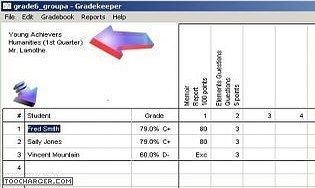
Many teachers work within common sets of standards. This can help keep the focus on what’s important. It helps them connect feedback on their work with overall course outcomes. This empowers the teacher to support the student with interventions targeted to their needs.In the example above, the gradebook invites the student to consider their grades and their knowledge of the content at the same time. A gradebook indexed to the learning outcomes can help a teacher diagnose what a student needs. This can also help teachers interested in data-based differentiation. Let’s look at an example of an imaginary results-focused gradebook. However, a gradebook that is tightly aligned with the outcomes of the course may look a bit different than either of these. The imaginary designers of the above gradebooks may be excellent practitioners of backward design – we can’t quite tell from the gradebook alone. Students can see they have certain assignments to do, but not what those assignments do for their learning.Īll too often the gradebook is an afterthought of the design. This leaves out what is covered in those chapters and why.The activity-focused student sees their work in terms of activities – there’s not much content in this gradebook. This may be appropriate, since some textbooks arrange chapters by objective, but this gradebook in particular only tells us that the chapters need to be covered. The coverage-focused student sees that there is a set amount of material to cover, but not what the material is teaching them. Take a look at these two imaginary grading strategies: It can also impact how students perceive the class. For the purposes of this article, suffice it to say that the grading strategy of a course can subtly influence its design. Neither case provides an adequate answer to the key questions at the heart of effective learning.” Understanding by Design, McTighe & Wiggins, 1998įor more information on the specific nature of activity-focused and coverage-focused design, do check out that book (if you haven’t already). “The ‘twin sins’ of typical instructional design in schools: activity-focused teaching and coverage-focused teaching.

They identify what they affectionately call the “twin sins” of instructional design: activity-focused teaching and coverage-focused teaching. In their seminal work Understanding by Design, McTighe & Wiggins remind us to keep our eyes on the guidelight when designing a course. Let’s take this a step further and talk about instructional design, specifically backward design. When it comes to staying consistent with your syllabus in times of change, percentage-category makes it a bit easier. Even outside of the pandemic we might need to omit an assignment or two. However, in a world where course plans can change, percentage-weighted categories have an administrative advantage. Moodle gradebook is able to accommodate either of these strategies. Otherwise the overall grade calculation would have been incorrect. I think one teacher had assignments worth 28.57 points after omitting work from a category. Teachers that followed the sum-of-points strategy needed to make some awkward changes to their gradebooks to accommodate omitted assignments. Teachers with percentage-category grading were able to flexibly add and remove assignments in an emergency without adjusting their syllabus. Whereas teachers in the sum-of-points camp had something like this in their syllabus: There’s nothing inherently wrong with either of these strategies, but percentage-category teachers typically had only categories and percentages in their syllabus, like this: The main difference is the way the teacher has conceptualized weight distribution.


Have a look at the two imaginary gradebooks below:Īt first glance, they appear to be using different strategies, but in reality they are mathematically very similar. We’ll call them Sum-of-Points and Percentage-Category. However, Individual View currently does not support settings and options from the Gradebook.There are two broad grading strategies in most US-based schools. The default view in the Gradebook is to view all students at a time, but you can also view students individually in the Gradebook Individual View. Not Graded assignments and unpublished graded assignments are not displayed in the Gradebook. Graded assignments, graded discussions, graded quizzes, and graded surveys that have been published in Canvas display in the Gradebook. Canvas Gradebook is a powerful tool that helps instructors easily view and enter grades for students.


 0 kommentar(er)
0 kommentar(er)
